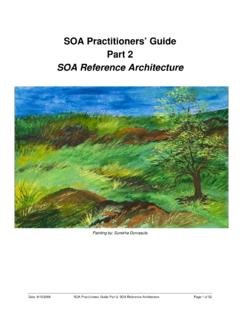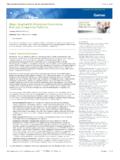Transcription of DoDAF 2.0 Viewpoints, Views, and Models - Binary Group, Inc.
1 DoDAF Viewpoints, Views, and Models DoDAF Viewpoints, Views, and Models After extensively covering architecture development, now it is time to explore the nitty gritty of the DoDAF viewpoints and Models . Use this as an opportunity to briefly introduce the students to each model. There is no need to go into every little detail of every model at this point in time. Utilize the case study you develop to explore the viewpoints and Models in greater depth. Also, the DoDAF website is a tremendous resource for your students. If they are having a difficult time mastering viewpoints and views, direct them to the website where all viewpoints and views are thoroughly discussed. All Viewpoint (required) (AV) Capability Viewpoint (CV) Data and Information Viewpoint (DIV) Operation Viewpoint (OV) Project Viewpoint (PV) Services Viewpoint (SvcV) Standards Viewpoint (STDV) Systems Viewpoint (SV) Models 1 May 10, 2010 Version DoDAF Viewpoints, Views, and Models DoDAF Viewpoints and Models DoDAF has been designed to meet the specific business and operational needs of the DoD.
2 It defines a way of representing an enterprise architecture that enables stakeholders to focus on specific areas of interests in the enterprise, while retaining sight of the big picture. To assist decision makers, DoDAF provides the means of abstracting essential information from the underlying complexity and presenting it in a way that maintains coherence and consistency. One of the principal objectives is to present this information in a way that is understandable to the many stakeholder communities involved in developing, delivering, and sustaining capabilities in support of the stakeholder's mission. It does so by dividing the problem space into manageable pieces, according to the stakeholder's viewpoint, further defined as DoDAF . described Models . Each viewpoint has a particular purpose, and usually presents one or combinations of the following: Broad summary information about the whole enterprise ( , high level operational concepts).
3 Narrowly focused information for a specialist purpose ( , system interface definitions). Information about how aspects of the enterprise are connected ( , how business or operational activities are supported by a system, or how program management brings together the different aspects of network enabled capability). However, it should be emphasized that DoDAF is fundamentally about creating a coherent model of the enterprise to enable effective decision making. The presentational aspects should not overemphasize the pictorial presentation at the expense of the underlying data. DoDAF organizes the DoDAF described Models into the following viewpoints: The All Viewpoint describes the overarching aspects of architecture context that relate to all viewpoints. The Capability Viewpoint articulates the capability requirements, the delivery timing, and the deployed capability.
4 The Data and Information Viewpoint articulates the data relationships and alignment structures in the architecture content for the capability and operational requirements, system engineering processes, and systems and services. The Operational Viewpoint includes the operational scenarios, activities, and requirements that support capabilities. The Project Viewpoint describes the relationships between operational and capability requirements and the various projects being implemented. The Project Viewpoint also details dependencies among capability and operational requirements, system engineering 2 May 10, 2010 Version DoDAF Viewpoints, Views, and Models processes, systems design, and services design within the Defense Acquisition System process. An example is the Vcharts in Chapter 4 of the Defense Acquisition Guide.
5 The Services Viewpoint is the design for solutions articulating the Performers, Activities, Services, and their Exchanges, providing for or supporting operational and capability functions. The Standards Viewpoint articulates the applicable operational, business, technical, and industry policies, standards, guidance, constraints, and forecasts that apply to capability and operational requirements, system engineering processes, and systems and services. The Systems Viewpoint, for Legacy support, is the design for solutions articulating the systems, their composition, interconnectivity, and context providing for or supporting operational and capability functions. DoDAF is a more focused approach to supporting decision makers than prior versions. In the past, decision makers would look at DoDAF offerings and decide which were appropriate to their decision process.
6 An example is the JCIDS process architecture requirements inside the JCIDS documentation (ICD, CDD, CPD, etc.). Additionally, older version Architectural Description products were hard coded in regard to content and how they were visualized. Many times, these design products were not understandable or useful to their intended audience. DoDAF , based on process owner input, has increased focus on architectural data, and a new approach for presenting architecture information has addressed the issues. The viewpoints categorize the Models as follows: The original viewpoints (Operational Viewpoint, Systems and Services Viewpoint, Technical Standards Viewpoint, and the All Viewpoint) have had their Models reorganized to better address their purposes. The Services portion of the older Systems and Services Viewpoint is now a Services Viewpoint that addresses in more detail our net centric or services oriented implementations.
7 All the Models of data (conceptual, logical, or physical) have been placed into the Data and Information Viewpoint rather than spread throughout the Operational Viewpoint and Systems and Services Viewpoints. The Systems Viewpoint accommodates the legacy system descriptions. The new Standards Viewpoint can now describe business, commercial, and doctrinal standards, as well as the technical standards applicable to our solutions, which may include systems and services. The Operational Viewpoint now can describe rules and constraints for any function (business, intelligence, warfighting, etc.) rather that just those derived from data relationships. 3 May 10, 2010 Version DoDAF Viewpoints, Views, and Models Due to the emphasis within the Department on Capability Portfolio Management and feedback from the Acquisition community, the Capability Viewpoint and Project Viewpoint have been added through a best of breed analysis of the MODAF and NAF constructs.
8 Workshops have brought the Systems Engineering community and the architecture community closer together in defining the DoDAF architecture content that would be useful to the Systems Engineering process, and this has resulted in an understanding which the entire set of viewpoints and the underlying architectural data can be used in the System Engineering processes. There is not a set of separate System Engineering viewpoint or DoDAF described Models as the system engineer and system engineering decision makers can use the existing DoDAF described Models and their own defined Fit for Purpose Views. The approach to the presentation of Architectural Description moves away from static and rigid one size fits all templates of architecture portrayals for architects. The term we have coined is "Fit for Purpose" presentation.
9 Through various techniques and applications, the presentation of Architectural data increases customer understanding and architecture 's usefulness to decision making by putting the data underlying the architectural Models into the context of the problem space for each decision maker. 4 May 10, 2010 Version DoDAF Viewpoints, Views, and Models All Viewpoints and Models There are some overarching aspects of an Architectural Description that are captured in the AV DoDAF described Models . The AV DoDAF described Models provide information pertinent to the entire Architectural Description rather than representing a distinct viewpoint. AV DoDAF . described Models provide an overview of the architectural effort including such things as the scope, context, rules, constraints, assumptions, and the derived vocabulary that pertains to the Architectural Description.
10 It captures the intent of the Architectural Description to help ensure its continuity in the face of leadership, organizational, and other changes that can occur over a long development effort. Uses of All Viewpoint DoDAF described Models The AV DoDAF described Models captures the scope of the architecture and where the architecture fits in relationship to other architectures. Another use of the All Viewpoint is for the registration of the architecture to support the net centric goals of making Architectural Descriptions visible (Discoverable). Mappings of the All Viewpoint DoDAF described Models to the DM2 Concepts, Associations, and Attributes are in DM2 Concepts, Associations, and Attributes Mapping to DoDAF . described Models . The DM2 Concepts, Associations, and Attributes are described in the DoDAF Meta model Data Dictionary.





